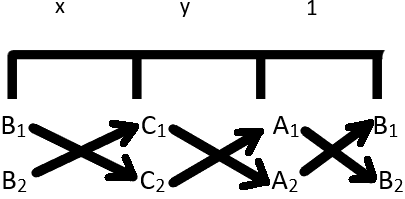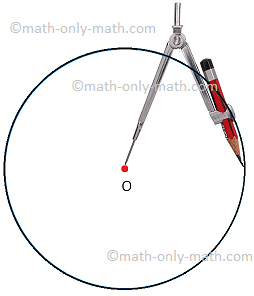Method of Cross Multiplication
The next
method of solving linear equations in two variables that we are going to learn
about is method of cross multiplication.
Let us see the steps followed while soling the linear equation by method of cross multiplication:
Assume two linear equation be
A1 x + B1y + C1 = 0, and
A2x + B2y + C2 = 0.
The coefficients of x are: A1 and A2.
The coefficients of y are: B1 and B2.
The constant terms are: C1 and C2.
To solve the equations in a simplified way, we use following table:
\(\frac{x}{B_{1}C_{2} - B_{2}C_{1}} = \frac{y}{C_{1}A_{2} - C_{2}A_{1}} = \frac{1}{A_{1}B_{2} - A_{2}B_{1}}\)
Equating one another we find the value of x and y of the given equations.
Let us solve some examples based upon this concept:
1. Solve for ‘x’ and ‘y’:
3x + 2y + 10 = 0, and
4x + 5y + 20 = 0.
Solution:
Let us solve the given equations using method of cross multiplication:
The coefficients of x are 3 and 4.
The coefficients of y are 2 and 5.
The constant terms are 10 and 20.
The table can be formed as:
\(\frac{x}{B_{1}C_{2} - B_{2}C_{1}} = \frac{y}{C_{1}A_{2} - C_{2}A_{1}} = \frac{1}{A_{1}B_{2} - A_{2}B_{1}}\)
On substituting respective values, we get:
\(\frac{x}{2 × 20 - 5 × 10} = \frac{y}{10 × 4 - 20 × 3} = \frac{1}{3 × 5 - 4 × 2}\)
\(\frac{x}{-10} = \frac{y}{-20} = \frac{1}{7}\)
Equating x term with constant term, we get x = -\(\frac{10}{7}\).
On equating y term with constant y term, we get y = -\(\frac{20}{7}\).
2. Solve for x and y:
6x + 5y + 15 = 0, and
3x + 4y + 9 = 0.
Solution:
Let us solve the given equation using method of cross multiplication:
The coefficients of x are 6 and 3.
The coefficients of y are 5 and 4.
The constant values are 15 and 9.
The table can be formed as:
\(\frac{x}{B_{1}C_{2} - B_{2}C_{1}} = \frac{y}{C_{1}A_{2} - C_{2}A_{1}} = \frac{1}{A_{1}B_{2} - A_{2}B_{1}}\)
On substituting respective values, we get;
\(\frac{x}{5 × 9 - 4 × 15} = \frac{y}{15 × 3 - 9 × 6} = \frac{1}{6 × 4 - 3 × 5}\)
\(\frac{x}{-15} = \frac{y}{-9} = \frac{1}{9}\)
On equating x term with constant term, we get x= \(\frac{-15}{9}\), i.e., x = -\(\frac{5}{3}\).
On equating y term with constant term we get, y = \(\frac{-9}{9}\)
= -1.
3. Solve for x and y:
5x + 6y + 10 = 0, and
2x + 9y = 0.
Solution:
The coefficients of x are 5 and 2.
The coefficients of y are 6 and 9.
The constant terms are 10 and 0.
The table can be formed as:
On solving, we get:
\(\frac{x}{B_{1}C_{2} - B_{2}C_{1}} = \frac{y}{C_{1}A_{2} - C_{2}A_{1}} = \frac{1}{A_{1}B_{2} - A_{2}B_{1}}\)
On substituting respective values, we get;
\(\frac{x}{6 × 0 - 9 × 10} = \frac{y}{10 × 2 - 0 × 5} = \frac{1}{5 × 9 - 2 × 6}\)
\(\frac{x}{-90} = \frac{y}{20} = \frac{1}{33}\)
On equating x term with constant term, we get x = \(\frac{-90}{33}\) = -\(\frac{30}{11}\).
On equating y term with constant term we get, y = \(\frac{20}{33}\).
4. Solve for x and y;
x + y + 10 = 0.
3x + 7y + 2 = 0.
Solution:
The coefficients of x are 1 and 3.
The coefficients of y are 1 and 7.
The constant terms are 10 and 2.
The table can be formed as:
On solving this table we get,
\(\frac{x}{B_{1}C_{2} - B_{2}C_{1}} = \frac{y}{C_{1}A_{2} - C_{2}A_{1}} = \frac{1}{A_{1}B_{2} - A_{2}B_{1}}\)
On substituting respective values, we get;
\(\frac{x}{1 × 2 - 7 × 10} = \frac{y}{10 × 3 - 2 × 1} = \frac{1}{1 × 7 - 3 × 1}\)
\(\frac{x}{-68} = \frac{y}{28} = \frac{1}{4}\)
On equating x term with the constant term, we get; x = \(\frac{-68}{4}\) = -17
On equating y term with the constant, we get; y = \(\frac{28}{4}\) = 7
From Method of Cross Multiplication to HOME PAGE
Didn't find what you were looking for? Or want to know more information about Math Only Math. Use this Google Search to find what you need.
Recent Articles
-
Dividing 3-Digit by 1-Digit Number | Long Division |Worksheet Answer
Apr 24, 24 03:46 PM
Dividing 3-Digit by 1-Digit Numbers are discussed here step-by-step. How to divide 3-digit numbers by single-digit numbers? Let us follow the examples to learn to divide 3-digit number by one-digit nu… -
Symmetrical Shapes | One, Two, Three, Four & Many-line Symmetry
Apr 24, 24 03:45 PM
Symmetrical shapes are discussed here in this topic. Any object or shape which can be cut in two equal halves in such a way that both the parts are exactly the same is called symmetrical. The line whi… -
Mental Math on Geometrical Shapes | Geometry Worksheets| Answer
Apr 24, 24 03:35 PM
In mental math on geometrical shapes we will solve different type of problems on simple closed curves, polygons, basic geometrical concepts, perpendicular lines, parallel lines, circle, terms relates… -
Circle Math | Terms Related to the Circle | Symbol of Circle O | Math
Apr 24, 24 02:57 PM
In circle math the terms related to the circle are discussed here. A circle is such a closed curve whose every point is equidistant from a fixed point called its centre. The symbol of circle is O. We… -
Fundamental Geometrical Concepts | Point | Line | Properties of Lines
Apr 24, 24 12:38 PM
The fundamental geometrical concepts depend on three basic concepts — point, line and plane. The terms cannot be precisely defined. However, the meanings of these terms are explained through examples.





